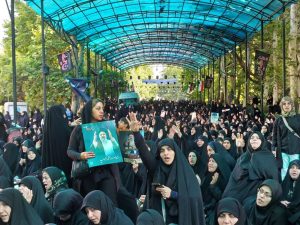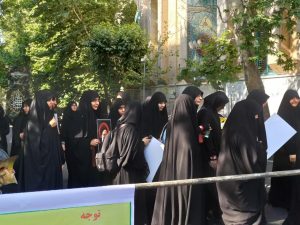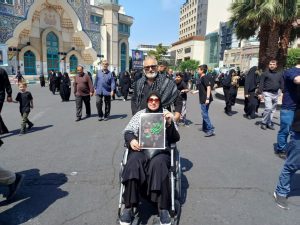In Tehran, Tabriz, Qom and Mashhad all Iranians especially women attended the funeral of their dear president and his companions in the helicopter accident to show their gratitude to all the services that president Raesi did for the Iranian nation.


















What it means to be a man is changing. Critical men or masculinity studies is an emerging robust research field that explores how men and masculinity are being transformed by shifting socio-economic, sexual and political conditions in our post-industrial world.
Fascinating new male-identifying sub-cultures and communities have emerged, like mushroom core and dandies. Yet heteronormative masculinity is typically framed as threatening, toxic or maladaptive, as in the case of fragile masculinity.
In my years of swiping on dating apps, I encountered different kinds of masculinities, as well as some very offensive and bizarre behaviors. Particularly perplexing was how quickly men vanished—or ghosted—when in-person dates were suggested, despite saying that they wanted physical intimacy. This was confusing and seemed to contradict the dominant narrative that men use dating apps primarily for hookups.
If not for sex, what are straight men doing on the apps? Are dating apps impacting masculinity? How do these changes in gender and tech landscape impact women’s sexual possibilities?
As a sexuality scholar and a woman who has sought intimacy with men on dating apps, these are important questions. I explore many of them in Sticky, Sexy, Sad: Swipe Culture and the Darker Side of Dating Apps, where I applied my academic training as an anthropologist to my dating life.
My book is based on notes that were taken between 2017 and 2022, when I was actively swiping on dating apps. No real names or identifying information are included in these data. Using the researcher’s life as subject is called auto-ethnography, and it’s an established approach that combines documentation with creative or literary techniques, memoir and cultural critique. Auto-ethnography is about articulating insider knowledge of certain cultural experiences of which the researcher is a participant.
Here are some of the most important things I learned about men and male sexual vulnerability while swiping my way into the dark heart of modern romance.
Dating apps provide very little instruction for how to date beyond a few dos and don’ts, but there are other resources men can access, including books and coaching services, to fill the void. The problem is that many are business-oriented or rooted in sexist bro culture ideology, where women are positioned as opponents or prizes to be tricked into submission.
Take the titles of some of the leading dating books for men: “The Mystery Method: How to Get Beautiful Women Into Bed“; “No More Mr. Nice Guy! A Proven Plan for Getting What You Want in Love, Sex and Life“; “The Foundation: A Blueprint for Becoming an Authentically Attractive Man“; and the classic “The Game: Penetrating the Secret Society of Pickup Artists.”
Also, most dating and relationship coaches, even those who are male, target their services to women, who are consistently framed as searching for love and wanting to understand men. On the other hand, men are typically seen as only wanting sex.
One thing that was very clear during my swiping odyssey is that guys want physical intimacy and are eager to talk about it with people they trust. In my in-person dates and text exchanges with men, I would often ask about their experiences with swiping out of a desire to understand the men better and to provide a compassionate ear. Most of them were eager to share their encounters on dating apps, including the factors that were standing in their way from being able to follow through on the intimacy they were seeking.
The first factor is the gamification of dating: how dating apps are marketed as a game with endless options. This keeps men swiping and can make decisions about who to talk to or get together with feel somehow misaligned with the whole swiping endeavor.
Add to this the links between gaming culture and misogyny, and it’s no wonder men regularly sacrifice sex and intimacy in the name of the swipe.
The second factor is the lack of quality sexual education and resulting dependence on porn. Many matches I spoke with said they learned about sex from pornography sites like Porn-Hub. These sites often depict women in hyper-sexualized ways and don’t include dialogues about how the men featured feel about what they’re doing in an emotional sense. Excessive porn can lead to sexual dysfunction, which has been linked with an increase in sexual vulnerability and anxiety around sex.
The third factor is the perceived social pressure to be sexually sophisticated, to mirror the adventurous lives of celebrities and sports figures. Some men inflate their number of sexual partners or brag to their friends about doing certain acts to uphold a study image. Yet in our interactions, they shared feelings of guilt and shame about lying to their friends and not being “good enough” at sex. Sometimes this means men avoid sex all together.
The fourth factor is the impact of the #MeToo movement, which began in 2017, around the time I started swiping. Men talked about feeling nervous and worried that they may come across as a creep or overly aggressive for something as simple as showing an interest in women on dating apps. They explained that this is why many of them ignore women who communicated with them or why they flake out on scheduled dates.
In many cases just talking about sex, let alone doing it, can feel too risky.
The fifth factor is the way dating platforms are designed, specifically Bumble. Until April 30 of this year, the heterosexual version required women to make the opening move and men had to wait to be asked out. Intended to put women in the driver’s seat, the role reversal seemed to make men uncomfortable, even though they were aware of the app’s design when they joined.
Indeed, the levels of misogyny on Bumble far exceeded what I experienced on any other swiping platform. This aligns with studies that show how a perceived lack of autonomy and independence—common attributes of masculinity—contribute to toxic masculinity.
Beneath the negative gloss of toxic masculinity, there is a steady stream of vulnerability regarding sex, intimacy and identity among men in our complex contemporary world. These insights enrich our knowledge about how straight men feel about these issues, including sex, which is something that many are willing to forego rather than get wrong.
Men need and deserve to learn about sex, relationships, gendered communication and themselves in ways that are inclusive, welcoming and supportive. As a recent article in The Washington Post stated, when we teach boys and young men to diminish or ignore their emotions and sexual desires, this leads to poor health outcomes, including rising rates of suicide and unsatisfying or violent relationships.
Let’s make the future of dating sexier and safer by making space for boys, men and male-identifying people to explore and learn about these vital aspects of life in a different way.
Source: The Conversation
Returning to work after parental leave can be one of the most challenging experiences for any parents, especially mothers, to navigate. Fortunately, there are simple, kind and thoughtful ways in which organizational members—regardless of formal status, parental identity or gender identity—can help mothers feel supported as they return to work, which can also benefit job satisfaction and maternal well-being.
New research published in Organizational Behavior and Human Decision Processes by Carlson School of Management Professor Nitya Chawla, leading a national team of researchers, examined the impact of allyship in the workplace for mothers after childbirth.
They collected qualitative data from 45 mothers to learn about specific behaviors they viewed as true allyship. Then, they conducted a study of 155 postpartum mothers who returned to work in the preceding four months to better understand the implications of postpartum allyship for mothers’ well-being, career decisions and family lives.
The team found:
“In a country that lacks paid federal leave, working mothers are often forced to return to work far before they are ready—a significant factor in influencing women’s decisions to leave the labor force,” said Chawla.
“While we may still be years away from any change to federal policies, there are ways in which we can assist mothers as they return to work postpartum and reduce their inclinations to leave. Postpartum allyship behaviors help working mothers feel like they can bring their whole selves to work, with both their professional and maternal identities living in one space.”
Source: PHYS.ORG
According to the latest available data, around 3.7 million Ukrainians are internally displaced, while nearly 6.5 million have registered as refugees globally. With 1.13 million, Germany has taken in the largest cohort.
Swift and decisive measures were taken to bring Ukrainian refugees into Germany in 2022: shortly after the Russian offensive began, Ukrainian arrivals were granted immediate employment rights and social benefits, including medical care.
Unlike other asylum seekers in Germany, Ukrainians have also been permitted to travel back and forth to their country of origin without losing their entitlements.
These expedited policy changes granted Ukrainian refugees privileges that were not extended to others. For example, in 2015, many Syrian refugees who had traveled on foot through the Balkans, Hungary and Austria were pushed back at the German border after Germany decided to reintroduce border controls.
This unequal treatment shows how Ukrainian refugees have been positioned as uniquely deserving arrivals to Europe. Ukraine’s martial law also prohibits most men aged 18-60 from leaving the country, meaning the majority of international refugees are women and children.
Studies have shown that gender plays a significant role in the experiences of displaced people. It can influence policy decisions that directly affect them, and impacts how they are represented, understood and integrated into host countries.
Our research, published in December 2023, set out to interrogate how Ukrainian women are portrayed in German public media, and what this can tell us about how Germany perceives its refugee population.
In our study, we analyzed 79 articles on female Ukrainian refugees from two high circulation German news outlets, Der Spiegel and Die Zeit, published during the first year of the latest Ukrainian conflict. We found that the dominant discourse presents Ukrainian women in Germany as keeping children safe, and as willing, able workers who will contribute to their host’s economy.
Notably, early reports also paid significant attention to Ukrainian women’s aspirations, future plans, and dreams, as well as the practical compromises they make in pursuing them. Some of these attributes are emphasized in profiles that have appeared elsewhere in German media.
We identified and explored five key characteristics that appear in the media depictions of displaced Ukrainian women: they are familiar, educated, hard-working, grateful and welcome.
One interview with Lena, a Ukrainian woman, is recounted as follows: “‘We are very grateful,” says Lena. Every few minutes she says thank you for anything or everything.”
Lena is also quoted as saying “we want to be useful for Germany and for ourselves.” The article states that she wants to “learn the language, earn money and pay taxes. She wants to be a part of this society and give something back as soon as she can.”
Ukrainian women are often presented as productive participants in the German labor market, or they express their aspiration to do so in the near future. Another interviewee says “I have completed my B1 German course, now B2 follows… I’ve already been promised a job in a hospital near Frankfurt am Main, but I still need the professional permit and a few other documents. It takes a long time.”
Ukrainian women are also portrayed as willing to assist with maintaining their hosts’ ideals and values of cooperation, diplomacy and education. For instance, one Ukrainian woman is quoted as saying “I myself am more useful to Ukraine when I’m here. I earn money with my work and send some of it home, among other things, I donate to the Ukrainian army.”
It is crucial to note that these interviews and stories are filtered through media outlets for a German audience. One journalist’s reporting on a Ukrainian woman’s desire to study at university is especially telling: “It’s as if the 22-year-old wanted to give a personal response to the violence unleashed by Russia in her homeland: more education, more international understanding, more Europe.”
While such reporting may, admirably, aim to humanize refugees, it can lead to unrealistic expectations. Focusing on their potential for providing economic or cultural benefits can obscure the challenges they face as humans seeking shelter from conflict.
Over the course of our research, we concluded that the ideal female refugee would be something akin to Mary Poppins, from the well known Disney 1964 musical fantasy film of the same name: she arrives unexpectedly, brings little baggage, is well spoken, well mannered, and able to fit into her hosts’ lives, leaving only positive impacts. She is, in her own words, “practically perfect in every way.”
Portrayals such as these are ultimately harmful to all displaced people. By uplifting one group, they cast a shadow on those who do not fit the bill, but they also raise expectations of the contributions refugees can make. Those who are unable to fit into this “practically perfect” category for a variety of reasons—be they economic, professional or cultural—may find themselves excluded or vilified.
Likewise, idealized constructions of Ukrainian women displaced by conflict may also work against them, obscuring the important challenges they face, such as the slow and difficult process of getting Ukrainian qualifications recognized in Germany.
Our study aims to sidestep the “common sense” ideas about displaced people that often dominate public policy and debate. These tend to focus more on what refugees can bring to the table than their intrinsic right to universal protection.
Source: PHYS.ORG
The Bureau of Labor Statistics found only 89 percent of working-age men had a job or were actively looking for work. That’s a significant drop from 1950 when the number was 97 percent. So while women are increasingly looking for work, many men are simply opting out.
“The U.S. has a major issue of prime-age men giving up and permanently exiting the labor force,” Robin Brooks, a senior fellow policy research firm at the Brookings Institution and the former chief economist at IIF, wrote on X, formerly Twitter this month. “What’s striking about this is that it doesn’t get talked about at all, not in the mainstream media and not by economists, even though this obviously feeds political radicalization.”
Men are opting out of the workforce for various reasons, but a key factor in the story is men’s dwindling rates of higher education attainment. While women historically were left out of college education, they now outpace men at college roughly 60 to 40 percent.
Not having a college degree invariably limits your employability, statistics show.
Those with only a high school diploma have an unemployment rate of 3.9 percent compared to just 2.2 percent of those who achieved a bachelor’s degree, according to the Bureau of Labor Statistics.
Other times, the desire to opt out of capitalist society might cause many to abandon the workforce altogether.
“Many jobs are simply not satisfying,” Yvonne Vising, a professor at Salem State University and an expert on the changing role of men in society, previously told Newsweek. “Working for others who get the benefit of our physical labor and intellectual property is not rewarding either emotionally or financially. People want to work doing jobs that matter to us. We want to use our creativity. We want to matter, and in many businesses, employees simply don’t get treated with the respect and support that we need and want. People walk away from them.”
In other cases, men have left the workforce to become stay-at-home parents, similar to many women today. Others rely on social safety net programs like Supplemental Security Income and Social Security for disabilities that might not have been recognized in earlier years.
Still, that doesn’t fully explain why at the same time women are working more while men are working less.
If you ask HR consultant Bryan Driscoll, it could largely in part come down to a mental health crisis among men that is not often addressed within society or in the workplace.
“This tells me that even with the push to be more mindful and aware of employee’s mental health issues and wellbeing, men are being left out,” Driscoll told Newsweek.
But if the trend continues, and men continue to fall out of the workforce, Driscoll foresees widespread social and economic implications.
“From a purely economic standpoint, a shrinking labor force reduces the potential for economic growth, limits our ability to fund social programs, and may contribute to skill shortages in critical industries,” Driscoll said. “Societally, the absence of young men from the workforce contributes to issues of social cohesion, increases dependency on welfare systems, and can exacerbate feelings of disenfranchisement and alienation.”
Still, it might not be time to sound the alarm yet. In some ways, the dwindling numbers of men in the workforce as women’s working numbers climb higher could just reflect a leveling of the playing field, Driscoll said.
“The decline in male labor force participation could be seen as a leveling of the playing field, offering a silver lining by potentially opening more opportunities for women and addressing longstanding gender imbalances in employment,” Driscoll said.
Jennifer Lee Magas, vice president of Magas Media Consultants and an assistant professor at Texas Tech University, echoed this statement, saying today’s lingering wage gap still shows there’s plenty that still needs to be done to deliver true equity in the workforce.
“It’s not about women replacing men, but rather an evolution of roles and opportunities,” Magas told Newsweek. “Female-dominated industries such as healthcare and education are experiencing growth, while traditionally male-dominated sectors like manufacturing are shrinking.”
Source: News-Week
There are two opposing bills in the state Legislature aimed at reforming the underground sex work industry and squashing the nasty web of human trafficking that fuels it.
But the proposed solutions — one led by Democratic Socialist lawmakers and another spearheaded by veteran state Sen. Liz Kreuger — are not just in competition, their supporters are convinced the others’ bill will make the problem worse.
“The countries that have gone down that road [of full decriminalization] have basically opened the floodgates of more trafficking, and more exploitation of these vulnerable young people, men and women,” Krueger, a Manhattan Democrat, said.
Krueger, along with Syracuse Assembly member Pamela Hunter, is sponsoring a bill that would shield sex workers from prosecution and expunge their past convictions — all while ensuring others involved in the transaction (like the pimps and sex buyers) can still be prosecuted.
On the other side of the issue, Democrats state Sen. Julia Salazar of Queens and Assembly member Phara Souffrant Forrest of Brooklyn are pushing a bill that would ensure “consenting adults who trade sex, collaborate with or support peers, or patronize adult sex workers will not be criminalized.”
Souffrant Forrest is just as convinced that Krueger’s bill would make the problem worse.
“That model still does not protect people, particularly the sex workers,” Souffrant Forrest said of Krueger and Hunter’s bill. “Now you’re forcing people to go into hiding, into clandestine, and because you’re charging the john, it still does not remove the stigma.”
Salazar agreed: “In places where sex work is actually fully decriminalized, sex workers and people who are consenting adults who participate in the sex industry actually have the ability to report abuse and crimes they are afraid to report right now.”
The two bills are coming to a head as the legislative session is set to end June 6 and as victims’ advocates say sex trafficking and prostitution are on the rise in New York City and state. At the same time, arrests for prostitution and sex buyers has plummeted ever since district attorneys’ offices in the city largely stopped prosecuting prostitution cases.
The issue has led to open-air prostitution markets in parts of Brooklyn and Queens. Mayor Eric Adams has oft-expressed his concern about the problem, and he told reporters he visited Queens’ Roosevelt Avenue at 1:30 a.m. recently to observe the problem.
“This is where idealism collides with realism,” Adams told reporters at a media briefing in October. “While we are fighting to address the issues of sex workers, sex trafficking, there are elected officials who are fighting against us trying to legalize sex work.”
A few months later, the NYPD shut down 12 brothels on the avenue.
Krueger and Hunter’s bill would also increase penalties for individuals who traffic people to themselves for sex.
“We are witnessing in New York City, and probably at the Canadian border as well, a sex trafficking crisis that we haven’t seen in decades,” Taina Bien-Aimé, executive director of the Coalition Against Trafficking for Women, said at a rally Tuesday at the Capitol.
“We’ve intercepted messages, emails and texts from pimps and traffickers from across the country, saying, ‘Come to New York City, it’s open for business, no one’s getting arrested.’” — Jason Beeferman
Source: Politico
Iranian security forces have arrested more than 260 people, including three European nationals, at a “Satanist” gathering west of the capital Tehran, the semi-official new agency Tasnim reported on Friday.
The raid follows a nationwide crackdown against women accused of flouting Iran’s strict Islamic dress code.
“Satanist network broken up in Tehran, arrests of three European nationals,” Tasnim wrote.
It said 146 men and 115 women had been arrested and that alcohol, banned under Iran’s Islamic laws, and psychedelic drugs had been seized.
The news agency also published photographs alongside its report showing masks, what appeared to be model skulls and T-shirts with skulls on.
The report did not give the nationality of the Europeans.
Source: Reuters
With the oldest population in the European Union, where one in four are aged over 65, it’s little surprise that Italy is home to the world’s fastest 90-year-old woman sprinter.
Emma Maria Mazzenga claimed another world record in the 90 and over age group this month when she ran the 200 meters outdoors in 51.47 seconds.
Born on Aug. 1, 1933, Mazzenga is one of the unsung stars of Italian athletics, currently holding five world records, nine European records and 28 best Italian performances in various categories of Masters sprinting – competitive races for older runners organized by age group.
“I am very happy and satisfied, and also a bit surprised because I didn’t think I went that fast,“ Mazzenga said modestly after her record-breaking run on May 5, beating the previous record of 53.35 seconds set by Japan’s Emiko Saito in 2022.
The women’s 200 meters world record, one of the oldest athletics records on the books, was set by the late American athlete Florence Griffith Joyner with a time of 21.34 seconds in 1988. She was 28 at the time.
The World Masters Athletics record for the women’s 50 and over category is 24.33 seconds, held by Jamaican-Slovenian athlete Merlene Ottey, while the record for women 70 and over is 31.30 seconds, held by Ingrid Meier of Germany. There is even a record for women aged 100 and over of 1 minute, 29. 79 seconds, held by Diane Friedman of the United States.
Like many athletes, Mazzenga follows precise rituals for her races: she runs strictly without socks and never wears the same shoes as for training.
She also likes to enjoy a beer with fellow runners to celebrate her successes, even though she usually has no direct rivals in her W90 category. “If I have no competitors, I know that I’ll win from the start, so my aim is to do a good time,“ she said the day after her latest world record, proudly polishing the trophies on display in her living room.
She ran as a young woman, but then stopped for many years after getting married and having children. Her running career as a Masters athlete, which she kicked off at the age of 53, has been an important comfort for Mazzenga’s later years. “It got me through some difficult times, which of course haven’t been lacking in a life as long as mine,“ she said.
Running “also allowed me always to be surrounded by a lot of people, so that I was never alone,“ she added.
Her next commitments include the Italian championships starting in June and she has an eye on the world championships in Sweden next year, but Mazzenga joked that she prefers “not to make long-term plans.”
Source: Yahoo News
A Nigerian rights group has launched a petition to stop plans by religious leaders and a state lawmaker to push 100 girls and young women into marriage in a mass ceremony next week, which have sparked outrage in the West African nation.
The plans, first revealed by Abdulmalik Sarkindaji, speaker of the national assembly in the largely Muslim northern state of Niger, were criticized by Nigeria’s women’s affairs minister Uju Kennedy-Ohanenye, who said she would seek a court injunction to stop the ceremony and establish if any of the girls were minors.
Sarkindaji said the girls and young women were orphans whose parents were killed in attacks by kidnapping gangs that roam northern Nigeria. He pledged to pay dowries to the bridegrooms.
The rights group Concerned Nigerian Citizens, in a petition launched on Wednesday that has garnered over 7,000 signatures, said the Niger state government should prioritise the education of the girls instead of forcing them into marriage.
“We demand immediate action to halt the proposed forced marriages and to instead implement measures that will empower these girls to lead dignified and fulfilling lives,” the group said.
But Sarkindaji and the Imams Forum of Niger said the marriage ceremony would go ahead on May 24.
The ages of the girls were not immediately known but the lawmaker and the Imams say they are not under age. Reuters was not able to identify or speak to any of the girls and young women.
Child marriages are common in the mostly Muslim north, where poverty levels are higher than the largely Christian south. Although the legal age of marriage is 18 under federal law, Nigerian states can set their own age.
Niger’s legal marriage age is also 18, Sarkindaji’s spokesperson Auwal Mohammed said, but added that under Sharia law, which is practiced in the state, a girl can be married upon reaching puberty.
After meeting on Wednesday, the Imams Forum said it would take legal action against the women’s affairs minister if she did not withdraw her statement suggesting the girls were minors, its secretary Umar-Faruk Abdullahi said on local TV.
“We have given the minister seven days to withdraw her statement she used against us, against our speaker, against the Muslim community .. that we want to force them into marriage and the children are under age,” said Abdullahi
Journalist Gayle King, plus-sized model Hunter McGrady and returning stars Chrissy Teigen and Kate Upton pose on separate covers unveiled on Tuesday for Sports Illustrated’s 60th annual swimsuit issue.
First-time Sports Illustrated model King, the 69-year-old co-host of “CBS Mornings,” smiled in a pink-and-green patterned one piece suit with spaghetti straps.
McGrady, who founded a fashion line for sizes up to 5X, wore a brown one-piece with large cutouts. She first appeared in the magazine in 2017.
Upton donned a pink and red ruffled bikini for her fourth swimsuit issue cover. Teigan, who graced the cover of the 50th anniversary issue, posed in an orange suit with a plunging neckline for the current issue, which will debut on newsstands on Friday.
The swimsuit issue debuted in 1964 and was known for showcasing skinny young women in revealing bikinis. In recent years, it has diversified its pool of models by featuring older women, larger bodies, trans models, Paralympic athletes and a woman in a burkini, a full-body swimsuit worn by some Muslim women.
“Over the past 60 years we have shattered stereotypes, embraced diversity, and championed inclusivity,” MJ Day, editor in chief of Sports Illustrated Swimsuit, said in a statement.
In addition to the four individual covers this year, the magazine released three others featuring groups of women who had appeared in the past, including Christie Brinkley, Martha Stewart, Megan Rapinoe, Paulina Porizkova and Tyra Banks.
Source: Reuters
All rights of this website belongs to Jahan Banou News agency. There are no obstacles in re-publishing the contents of this platform by mentioning the reference.